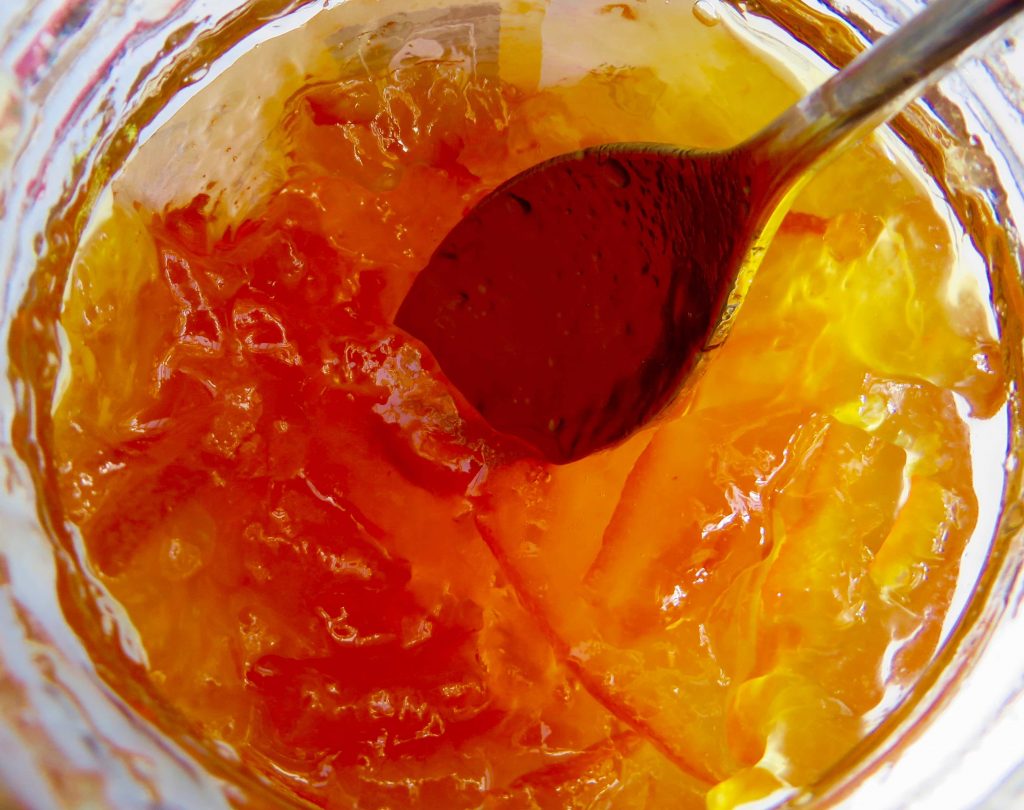Working from home during ‘coronavirus’ lockdown has meant that toast and marmalade, which we usually only have for breakfast on Saturdays and Sundays has been added to our normal weekday fare of yoghourt with cereal, fruit and nuts.
Our best choice is ‘Duchy’, organic thick cut but we’ve had to cast around when that wasn’t on the shelves. There’s quite a difference in quality and I became interested in how marmalade came into being in the first place.
It seems that historically marmalade was made of quinces and the word comes from Portuguese – marmelada.
In 1524 Henry VIII received a ‘box’ of marmalade from a Mr. Hull of Exeter. This was probably solid quince paste from Portugal. It was often flavoured with rose water and musk, or ambergris, then cut into squares like Turkish delight and packed into boxes – hence Henry’s ‘box’.
Quince paste is still available – more popular on the continent – it’s an interesting addition to cheese and biscuits. I find it goes particularly well with Manchego cheese.
There’s a note in Samuel Pepys’s diary on 2nd November 1663. ‘Left Mrs Hunt and my wife making marmalett of quinces’. In England in the seventeenth century citrus fruits became more plentiful because of foreign trade.
In James Boswell’s book ‘The Life of Samuel Johnson’,(published 1791), there are various references to marmalade. In a letter he writes to Johnson, Boswell says, ‘My wife is much honoured by what you say of her. She begs you may accept of her best compliments. She is to send you some marmalade of oranges of her own making’.
Marmalade, as we know it today, is a sort of jelly consistency, containing the juice, pulp and citrus peel of oranges, lemons, limes or grapefruit – or a combination of two or three. I remember my mother making ‘three fruit marmalade’ for the RNLI every year – maybe 200 pots of it – sitting in serried ranks on the dining room table, ready for the stall on ‘Lifeboat Day’. She also made apricot jam, adding fresh apricot kernels, which was delicious.
The best marmalade is made with bitter oranges from Seville. Cooked with sugar, the taste is both sweet and sharp. The favoured ‘Duchy’ marmalade has a robust taste and the peel is satisfyingly thick, with lots of it.
Marmalade got its jelly quality rather than solid ‘paste’ by pulling it from the heat earlier. Using whole oranges, lemons and sugar with the acid of the lemons helping to create pectin, ‘sets’ the jelly. Nowadays, you can just add ‘pectin’.
The peel should be evenly distributed throughout the jar. To achieve this at home, you should leave the marmalade after its setting point to cool and thicken for fifteen minutes before pouring into the jars.
If you want to look further into marmalade, there are stories, (which are unproven), like the one of Keiller’s Dundee marmalade, which was the result of oranges taken from a shipwreck and made into marmalade, no doubt laced with sea water – or search for the (unproven) link with Mary Queen of Scots, ‘Marie est malade’. Go to Wikipedia, which is a mine of information.
Edmund Hillary took a jar of marmalade up Everest in 1953. Captain Scott took jars of it to the Antarctic in 1910. A solitary jar was found, buried in the ice, years later.
Fortnum and Mason used to sell marmalade in tins, rather than jars. Today they offer a wide range of flavours, including ‘kumquat’ and ‘rose petal’.
English and Scottish migrants took marmalade to Canada, where it remains popular – but it didn’t hit the spot in the U.S.
Paddington Bear always had a pot of marmalade in his brief case and sometimes a marmalade sandwich tucked under his hat to keep him going. Sadly, his creator, Michael Bond, died last year but the books and films survive – to the delight of both children and adults worldwide.
This photo might tempt you to sit down with toast and marmalade at breakfast time. Funnily enough, I never want to eat it at any other time of day.

